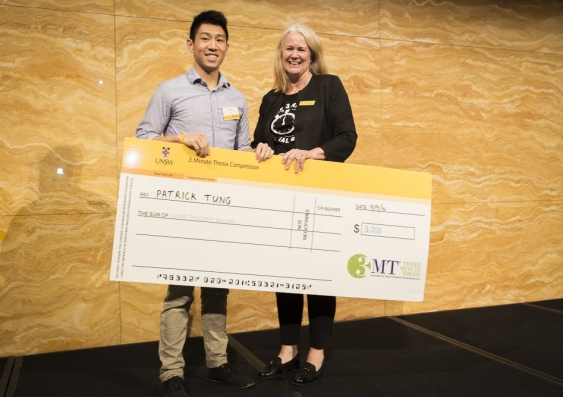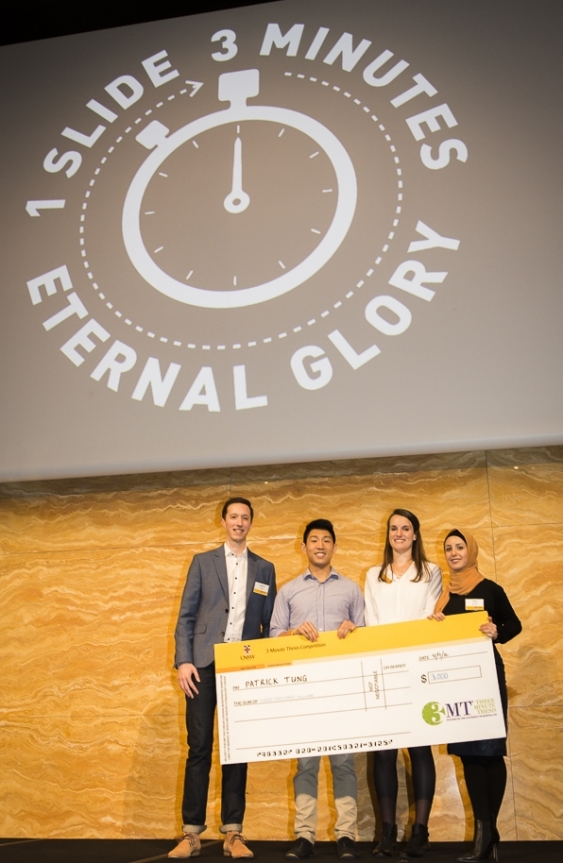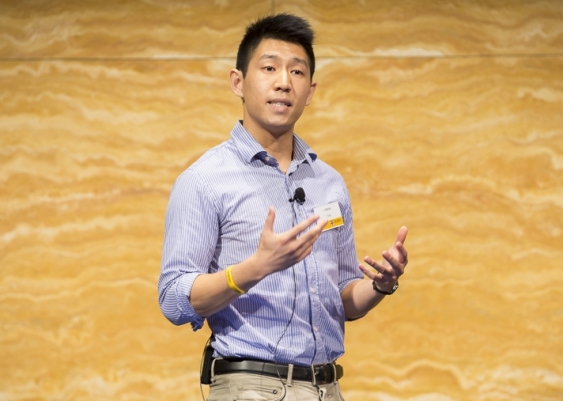Imperfection proves the perfect metaphor in 3MT final
A presentation about efforts to understand the imperfect atomic structures of lead-free piezoelectrics has taken top honours in the UNSW Three-Minute Thesis finals.
A presentation about efforts to understand the imperfect atomic structures of lead-free piezoelectrics has taken top honours in the UNSW Three-Minute Thesis finals.

Clare Morgan
UNSW Media & Content
(02) 9385 8920
clare.morgan@unsw.edu.au
In three minutes, most people can boil an egg. If you’re good enough, you can also demystify the complex world of piezoelectrics and explain your efforts to engineer a safer, lead-free version for use in devices such as pacemakers.
Patrick Tung’s confident and engaging talk won him the top prize at the UNSW Three-Minute Thesis (3MT) finals in a close competition that shared the honours across several faculties.
Patrick, from the School of Materials Science and Engineering, won $3000 and will represent UNSW at the Asia-Pacific Final in Queensland and the global U21 3MT.
Dean of Graduate Research Professor Laura Poole-Warren said: “3MT is a fabulous showcase of the outstanding research and researchers we have at UNSW and this year’s cohort was exceptional. We wish Patrick all the best in the Asia-Pacific Final and the U21 comp: he will have all of us cheering him on.”
The judges – Kathy Bail, CEO of UNSW Press, Tim Dean, Science and Technology editor of The Conversation, Tilly Boleyn, Science, Health and Medicine curator at the Powerhouse Museum, and acclaimed Australian photographer William Yang – admitted they had a tough time choosing an overall winner from the 23 PhD candidates from across the university.
Nancy Mourad (Medicine) was named runner-up and collected $1500 for her presentation, which likened dormant breast cancer cells that spread to bone with criminals plotting a deadly attack. Nancy also picked up the $500 ASPIRE prize, awarded by students from Canterbury Boys’ High School, Bass High School and Bankstown Girls High School.
Third prize ($500) was won by Vera Newman (Science) for her presentation on how stress affects people’s ability to think clearly and her research into strategies to overcome this impact.
The $1000 People’s Choice Award was won by Benjamin Walker (Business) for his burger-themed talk about interviewing elite Australian athletes to gain a better understanding of “performance-based identity” and how some achieve exceptional levels of performance thanks to their “special sauce”.
Benjamin also received an honourable mention from the judges, as did Sarah Mulholland (FASS) for her presentation on teacher knowledge of ADHD.

From left, Benjamin Walker, Patrick Tung, Vera Newman and Nancy Mourad. Photo: Jayne Ion
Judge Tim Dean said all the presentations were of an exceptional standard, which had left the judges deliberating for a long time.
“I know how hard it is to try to digest your many years of research into just a few minutes. To be able to step back and see the bigger picture and give it context … is a Herculean effort,” he said.
For the uninitiated, piezoelectrics are materials that can change their shape when you apply an electric field to them. They can also generate electricity when their shape changes. As Patrick explained, these properties are used in many applications, such as pacemakers.
However, across the $13 billion piezoelectric market, more than 95% of all piezoelectrics are made with lead because they provide the best properties. This has obvious health implications but even the best lead-free piezoelectrics are far inferior to the lead-based versions.
One solution is to enhance the properties of lead-free piezoelectrics, but to do that researchers must first understand how they work at an atomic level.
Using massive particle accelerators around the world that produce powerful x-rays, Patrick has been able to look at the atomic structures within these materials.

Patrick Tung delivers his Three Minute Thesis. Photo: Jayne Ion
“Usually, atoms in a material are perfectly ordered, just like the seats in this hall,” he said. “However, what we find is that atoms in lead-free piezoelectrics are completely disordered, with defects throughout the whole material. We see things like mismatching layers of atoms, atoms moving away from where they usually sit and smaller atomic structures forced within larger ones.”
Understanding these mechanisms would make it possible to engineer new materials and eventually replace lead in all piezoelectrics.
“So, it turns out that piezoelectrics are just like people: it’s the imperfections that make them interesting,” Patrick said.
After his win, Patrick said his heart was pounding as he waited to take the stage but once he was up there, everything kicked in.
To prepare his presentation, he first had to sit down and simplify his topic then try to make it as interesting as possible.
And the prize money?
“I think I’ll shout dinner for everyone who supported me,” he said. The rest would help fund overseas trips as part of his research.